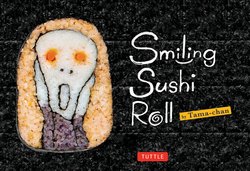Читать книгу Smiling Sushi Roll - Takayo Kiyota - Страница 5
На сайте Литреса книга снята с продажи.
Оглавление“God helps those who help themselves”
“ 神に見放された者は自らの手で運をつかめ ”
“The Thinker” by Auguste Rodin
オーギュスト・ロダン「考える人」より
“The Kiss” by Gustav Klimt
グスタフ・クリムト「接吻」より
The unique feature of the “Smiling Sushi Roll” is that you see something different each time you cut. The roll sometimes spins a story through changes in color and pattern.
『にっこり寿司』は、一本ののり巻きの中で色が変わったり、動きが加わったりしてストーリーが生まれることも。 だから切るたびに驚きは増し、見ている人の歓 声は大きくなってゆくのです。
“The Scream” by Edvard Munch
エドヴァルド・ムンク「叫び」より
Memory of My Travels in Spain
This building whose design emerges from the ground almost makes me forget that it’s a man-made object.
My sushi roll shapes are sometimes imperfect, but they get praise because “they’re not too exact.” People have such big hearts!
スペイン旅行の思い出
地面からニョキニョキ生えて来たようなデザインは 人工物であることを忘れてしまいそう。
私の巻き寿司もグニャグニャ、ニョキニョキしているけど 「まっすぐ、キッチリしてないからいい」と言われる。
みんな、心が広いな〜。
“Sagrada Família” by Antoni Gaudí
アントニ・ガウディ「サグラダ・ファミリア」より
Memory of My Journey in Italy
The Leaning Tower of Pisa became a popular tourist destination because of its slant. It’s like that with people too. A quirky person is more attractive than a perfect person who does everything right. Even this tower—its eccentricity kind of makes you want to support it. I supported my leaning tower with cheese. But, I haven’t made it to Pisa yet.
ィタリァ旅行の思い出
ピサの斜塔って傾いたから観光名所になったよね。 人だって何でも出来て完璧な人より、 ちょっとクセがある人に魅力を感じることの方が多い。 この塔だって、みんな思わず支えたくなっちゃうし。 私はチーズで支えてみました。 あ、ピサには行ったことないけどね。
変装するのは男だけじゃない。
My Japan
私 の 好きなニッポン
The Houshiwajo Standing Figure Face
「宝誌和尚立像」より
From inside his face…
顔が割れて中から…
The Houshiwajo standing figure can take you by surprise at first. The statue represents the idea that humans are inhabited by gods. So, the face of the figure has a crack, and the Amida Buddha is emerging from it. Houshiwajo was a Chinese monk who had thoughts and ideas beyond those of the ordinary person. His stories have been passed on from generation to generation. Fantastic!
宝誌和尚立像を京都の博物 館で初めて見た時、ビック リした。 ふざけている! い え、ふざけているわけでは なく「人は内面に神仏が宿 る」という意味が込められて 中から阿弥陀如来が現れてい るところらしい。 宝誌和尚は 風狂の僧で、一休さんのよう に常人の域を超えた中国の和 尚 さ ん。 こ ん な ふ う に 後 世 に 伝えられるなんて、宝誌和尚っ ておちゃめな人だったみたい。 ステキだね!
Houshiwajo Standing Figure, property of the Saioji Temple
Rolling rice within rice.
お米をお米で巻いてみた。
The Japanese kanji character for “rice” is kome ( 米 ).
One long roll cut once …
… cut twice ….
At the end you have the Japanese character for “rice.” That’s rice within rice within rice!
A Longing for the Edo Period
The oirans in ukiyoe paintings and the ninja you see in the movies don’t exist anymore. But some people out in the world believe they still do, the way they did in the Edo period. They were the idols and stars of their day. I think the Edo period must have been really cool!
あこがれの江戸時代
浮世絵の中の花魁も映画やドラマに出て来る侍や忍者も今はいない。
でも海外では今でもいると思われていたり。
私達は本物の侍も忍者も花魁も見たことってないけど、
江戸時代には確かに存在した。
アイドルもセレブもスターもいた江戸時代って、
とんでもなく楽しそうだな〜と思う。
“The Great Wave off Kanagawa” by Hokusai
葛飾北斎「神奈川沖浪裏」より
The Japanese Salaryman
“Nice to meet you.”
「はじめまして」
“Nice to meet you too.”
「お世話になります」
“I’m Yamada working for the
●× trading company.”
「●×商事の山田です」
“I’m Tanaka working for the
▲■ corporation.”
「▲■物産の田中です」
EROS
エロス
Bondage
During the Edo Period various ways of restraining prisoners were invented. After the Meiji Restoration bondage fetishism came out of the closet, with Japanese aesthetics.
緊縛
江戸時代、囚人の拘束のために様々な縛り方が考えられた。
日本人の美麗を求める感性も加わり、
明治維新以降そこに性的興奮を覚える嗜好が公になったそうだ。
エロと美は人を魅了し続ける。
“Completing Each Other” is a symbol of peace and happiness.
凸凹は、
「愛と平和」の象徴。
あなたなら何 をくわえる?
